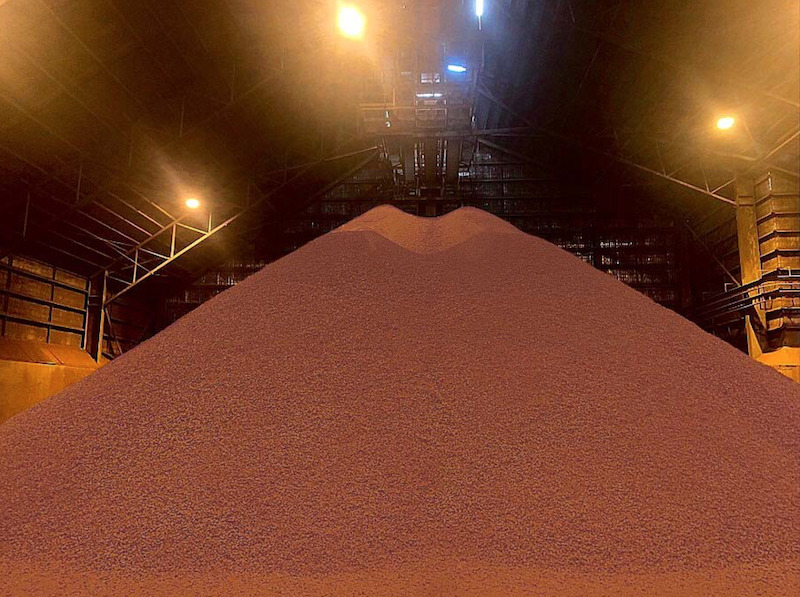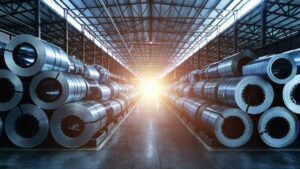Bulk Buys: GWR Group readies first shipment of iron ore as stellar price run continues

Pic: Schroptschop / E+ via Getty Images
- Iron ore fines prices traded up in the week just gone, reaching $US174.66 per tonne, building on nine-year highs reported this time last week to be up a further $US2.41.
- Hard coking coal prices were up around $US6 on-week at $US101.54 per tonne via Queensland ports.
- China’s reinforcing bar price is at $US663-$668 per tonne.
ASX-listed iron ore company GWR Group is about to join the iron rush, as the price for iron ore continues its blessed run. It’s jumped another $US2.40 in the week to sit close to the $US175/t mark on the back of record-breaking Chinese imports in 2020.
As reported by Stockhead yesterday, Chinese customs data shows the world’s largest steelmaker imported 1.17 billion tonnes of the commodity in 2020 – up 9.5 per cent from 1.069 billion in 2019.
The growth was said to be driven by increased spending on infrastructure designed to spur the economy on during the coronavirus pandemic.
It appears to have worked. China’s economy grew 2.3 per cent in 2020, making it the only major economy to expand in the pandemic year. The GDP grew 6.5 per cent in the final quarter alone – great news for those companies sending Aussie ore abroad.
Supply constraints in Brazil continue to drive the price of iron ore up as well. A terminal fire at Vale’s Ponta da Madeira terminal in northern Brazil this week caused concerns, though the facility did continue to run.
Looking at the year ahead, Reuters columnist Clyde Russell this week flagged a pulling back of economic stimulus combined with increased supply leading to price easing in 2021.
“While the steel-making ingredient is continuing its stellar run, the fundamentals may slowly be starting to turn against further gains, with easing prices seeming more likely,” he said.
“The main reasons to be cautious over the spot iron ore price are rising supply from top exporters Australia, Brazil and South Africa, and early signs that Chinese steel output is likely to stabilise this year.”
Coal also higher
The price of hard coking coal out of Queensland went above the $US100 mark this week, driven by firm demand and a limited amount of cargo available to the market, according to Metal Bulletin.
Chinese coal imports surged in December with a monthly record of 39.2 million tonnes brought in, taking the annual import total to 304Mt.
Australia’s slice of that pie was diminished by the ongoing import lockout, despite power outages in China said to be brought about by a lack of coal access.
Thermal coal has been in demand on the back of a cold northern winter, according to a note released last week from Wood Mackenzie’s head of thermal coal research Dale Hazelton.
“Colder than expected weather across China, Japan and Europe has driven power generation to record highs and spurred demand for coal,” he said.
“However, spot supply is limited after producers spent most of the year cutting production to align with the demand destruction of the pandemic.
“The cold weather won’t last and as we enter the warmer spring, prices will likely come off the boil, but it’s been a strong start to the year for producers.”
The temperature may be warming, S&P Global reported that China’s January reset on import quotas could still freeze out Australia’s coal producers in the new year.
GWR draws nearer at C4
In company news, ASX-listed iron ore company GWR Group announced yesterday that it was on track to make the historic first shipment of ore from its C4 iron deposit late in January, alongside alliance partner Pilbara Resource Group.
High grade lump and fines product is currently being stockpiled at the Port of Geraldton, where it will be loaded to cargo ship PANAFRICAN later in the month to head out to sea.
GWR has a 21.6 million tonne resource measuring 60.7 per cent iron, and is currently undertaking assessment and modelling to increase production tonnage on stage one of the project.

As reported by Stockhead columnist Guy Le Page last week, a number of other juniors are also on a roll in the space, looking to strike while iron is hot.
ASX iron ore company share prices
| Code | Company | Price | %Mth | %SixMth | %Wk | %Yr | MktCap |
| EUR | European Lithium Ltd | 0.11 | 139 | 100 | 100 | 17 | $50.9M |
| SRK | Strike Resources | 0.21 | 50 | 268 | 40 | 347 | $53.1M |
| ADY | Admiralty Resources. | 0.016 | 23 | 129 | 33 | 167 | $18.5M |
| TI1 | Tombador Iron | 0.086 | 54 | 309 | 32 | 309 | $61.8M |
| AKO | Akora Resources | 0.415 | 14 | 0 | 12 | 0 | $19.5M |
| CIA | Champion Iron Ltd | 5.31 | 7 | 84 | 9 | 85 | $2.6B |
| MGX | Mount Gibson Iron | 0.975 | 3 | 42 | 1 | -2 | $1.2B |
| MAG | Magmatic Resrce Ltd | 0.15 | -12 | -46 | 0 | -37 | $28.9M |
| MGT | Magnetite Mines | 0.015 | 25 | 717 | 0 | 301 | $40.0M |
| LCY | Legacy Iron Ore | 0.037 | 37 | 1133 | 0 | 1750 | $224.9M |
| FMS | Flinders Mines Ltd | 0.995 | -1 | 47 | -1 | -16 | $168.8M |
| FMG | Fortescue Metals Grp | 25.04 | 9 | 53 | -1 | 119 | $76.4B |
| GRR | Grange Resources. | 0.315 | 7 | 26 | -2 | 29 | $358.8M |
| MIN | Mineral Resources. | 38.46 | 15 | 61 | -3 | 121 | $7.3B |
| FEX | Fenix Resources Ltd | 0.265 | 15 | 258 | -4 | 382 | $119.1M |
Whitehaven optimistic on pricing future
In the coal space, producer Whitehaven Coal (ASX:WHC) revised its FY21 sales guidance last week, updating and tightening expected output to 19-20 million tonnes.
Whitehaven’s previous guidance had been 18.5-20 million tonnes for the financial year.
The company achieved run-of-mine production of 5.1 million tonnes in the December quarter – some 64 per cent higher than the previous corresponding period. Saleable coal production came in at 3.9Mt, which was 15 per cent higher than the previous corresponding period.
The company’s managing director and CEO Paul Flynn said the results and guidance change were testament to the company’s consistency of performance.
“Across our open cut operations we are seeing much more consistent and better performance across production and overburden management, and our guidance range has tightened accordingly,” he said.
“During the latter part of the December quarter there was a strong rebound in pricing and we are increasingly optimistic that underlying market dynamics are supportive of continued improvement in this area.”
Whitehaven reported average prices of US$62 per tonne and US$77/t for thermal and metallurgical coal respectively for the December quarter.
ASX coal company share prices
| Cpde | Company | Price | %Mth | %SixMth | %Wk | %Yr | MktCap |
| BRL | Bathurst Res Ltd. | 0.068 | 70 | 36 | 66 | -41 | $131.6M |
| PAK | Pacific American Hld | 0.026 | 13 | 189 | 13 | -5 | $7.9M |
| CRN | Coronado Global Res | 1.26 | 15 | 40 | 10 | -40 | $1.7B |
| WHC | Whitehaven Coal | 1.76 | 7 | 13 | 8 | -33 | $1.8B |
| SMR | Stanmore Coal Ltd | 0.84 | 6 | 30 | 6 | -15 | $227.1M |
| BCB | Bowen Coal Limited | 0.046 | -2 | -18 | 2 | -13 | $44.1M |
| TER | Terracom Ltd | 0.16 | -6 | 0 | 0 | -48 | $120.6M |
| NAE | New Age Exploration | 0.013 | 18 | 86 | 0 | 333 | $14.2M |
| LNY | Laneway Res Ltd | 0.007 | 0 | 0 | 0 | 17 | $26.4M |
| CKA | Cokal Ltd | 0.083 | 22 | 102 | 0 | 84 | $76.8M |
| AKM | Aspire Mining Ltd | 0.105 | 11 | 33 | 0 | -22 | $50.8M |
| MCM | Mc Mining Ltd | 0.155 | -18 | 55 | -3 | -67 | $29.3M |
| AHQ | Allegiance Coal Ltd | 0.07 | 40 | 6 | -5 | -48 | $59.5M |
| NCZ | New Century Resource | 0.22 | -15 | 10 | -6 | -21 | $272.2M |
| YAL | Yancoal Aust Ltd | 2.36 | 0 | 15 | -7 | -17 | $3.1B |
| JAL | Jameson Resources | 0.099 | -10 | -36 | -10 | -45 | $30.0M |
| PDZ | Prairie Mining Ltd | 0.27 | 50 | -16 | -18 | 20 | $63.9M |
Construction activity pause expected to hit rebar demand
The price of Chinese domestic rebar may have edged higher this week, but demand is anticipated to fall on the back of a COVID-19 outbreak in Shandong Province, Metal Bulletin reported.
All construction activity and a district of another city in the eastern Chinese province has been put on hold to combat the spread of the illness, according to the local government.
The province is said to have confirmed its first variant COVID case imported from the UK in the first week of the year.
UNLOCK INSIGHTS
Discover the untold stories of emerging ASX stocks.
Daily news and expert analysis, it's free to subscribe.
By proceeding, you confirm you understand that we handle personal information in accordance with our Privacy Policy.








